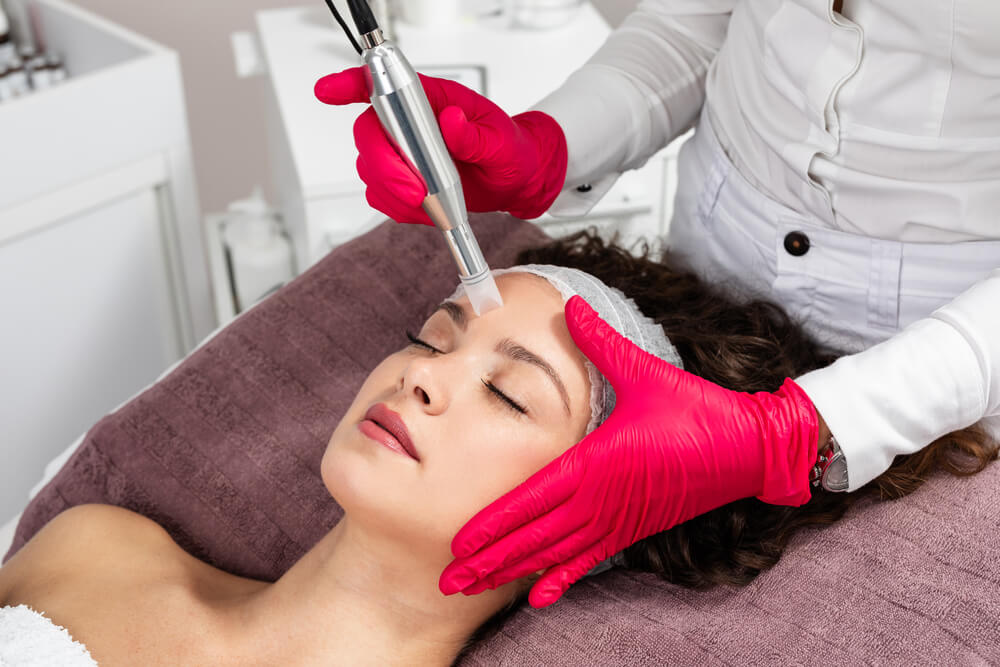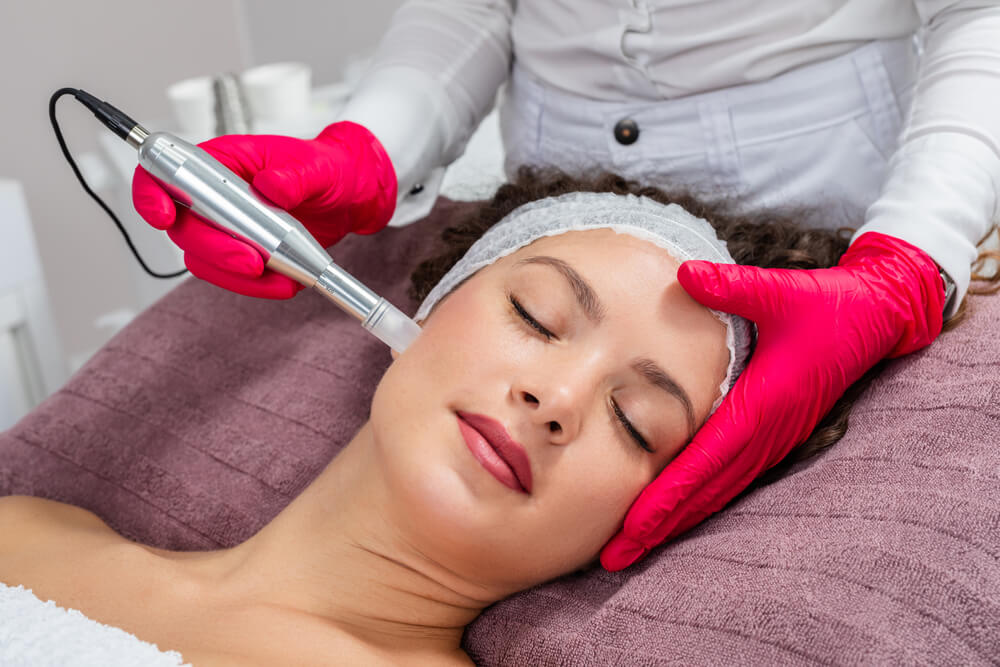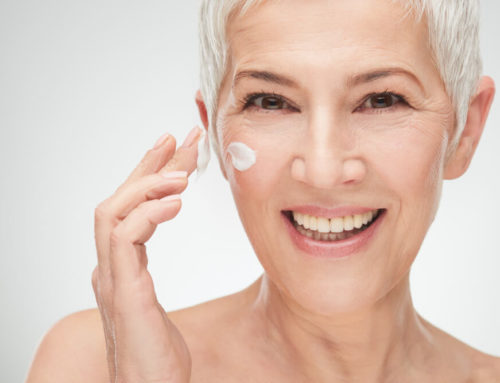Microneedling is a form of anti-aging cosmetic therapy.
In a typical session, the dermatologist will use a needle roller or other equipment to puncture the skin and promote new collagen growth. Microneedling is often referred to as percutaneous collagen induction or collagen induction therapy due to its ability to stimulate the body’s natural collagen production.
Platelet-rich plasma (PRP) can be administered to the session in two different ways: either through injection or topically. Possible benefits of microneedling with PRP include faster healing and less inflammation following the procedure.
Some research suggests that microneedling with plasma can enhance outcomes for patients with acne scars, but more evidence is still necessary.
In the following article, we’ll discuss the pros and potential cons of PRP microneedling. For more information on the matter, feel free to contact the PRP therapy specialist in Margate, Florida.
PRP Microneedling and Its Uses

Wrinkles, age spots, scars, and even some cases of hyperpigmentation can all be treated with conventional microneedling. And microneedling with PRP has the potential to enhance these outcomes and speed up the time it takes to reach your goals.
Although microneedling has been shown to be effective in treating stretch marks and scars on other parts of the body, most of the research on the use of PRP in scar treatment has focused on the face.
Microneedling followed by topical PRP application is commonly referred to as a “vampire facial.”
Due to the lack of significant risks associated with the procedure, most patients are suitable candidates for it. However, this may not be the case if you:
- Get scars too easily
- Take a long time to heal properly
- Are currently pregnant
- Deal with active acne
- Have recently used Accutane to treat acne
- Suffer from skin issues like rosacea and facial eczema
- Went through skin radiation in the year prior
After reviewing your medical records, your doctor will decide if microneedling with plasma is right for you.
Finding a medically qualified practitioner to carry out the surgery and walk you through the procedure is essential, despite PRP microneedling being minimally invasive. That said, with available PRP therapy in Margate, Florida, don’t hesitate to get more information if interested.
PRP Microneedling Before and After
Compared to other types of cosmetic surgery, microneedling with PRP is a relatively straightforward and brief technique.
Before the Procedure
Get there 15 minutes early to ensure you don’t have to wait long before seeing your doctor. As a result, you’ll have more time to finalize any remaining payments or documentation.
A nurse may provide you with a hospital gown to change into when you’re ready. Your doctor will clean your skin and then apply a local anesthetic. Before starting the microneedling process, the anesthetic must sit for at least half an hour.
During the Procedure
There are two stages to the actual process. Microneedling typically takes about 30 minutes but can vary greatly depending on the size and number of locations being worked on. At this appointment, your doctor will apply derma roller treatments to the targeted regions of your face using FDA-approved medical-grade equipment.
After numbing your face, blood will be taken from your arm using a syringe. Blood is centrifuged to isolate PRP from the rest of the blood’s components.
Once microneedling has been completed, the PRP solution can be massaged into the affected area. Microneedling works by making tiny holes in the skin, which the PRP may then seep through.
While PRP has traditionally been shot into the skin, its usage in conjunction with microneedling is becoming increasingly frequent.
After the Procedure
Your doctor may apply a balm or serum to reduce swelling and discomfort after the treatment. You can also try covering up any short-term skin irritation with makeup.
You are free to return home unless an allergic reaction has occurred. Even though many people are confident in their ability to drive home, it’s often best to have a ride ready for you ahead of time.
Possible Complications and Side Effects
The most typical adverse reactions are skin discoloration, redness, and edema due to inflammation. Usually, they show up right away after the treatment, and they go away within four or six days.
You should stay out of the sun and away from any harsh treatments for your skin at this time. Avoid touching your face too much, especially rubbing or picking at your skin.
Since PRP is made out of your blood, there is a low risk of spreading the infection to other areas. That said, infection and scarring are two very uncommon but potentially dangerous risks.
An outbreak of herpes simplex, popularly known as cold sores, could occur if you have a history of the virus before undergoing this operation. If you’ve ever had cold sores, it’s vital to tell your doctor about it.
The Recovery Process
Microneedling with plasma has a short recovery time. You are free to resume your normal activities the next day.
You should try to limit the number of skin care products, as slight irritation and redness are still possible. In addition to your daily cleansing routine, apply moisturizer as needed. Use a light foundation or powder to conceal any remaining redness further.
During the healing process, you should avoid using exfoliants and anything with alcohol in it. Having adequate protection from the sun is also crucial.
Do not engage in strenuous physical activities that could lead to excessive perspiration and heat production until your skin has fully healed. Physical exertion raises the risk of bruising and swelling, and sweating can aggravate existing discomfort.
PRP Microneedling Before and After: ResultS

Although there is some indication that using PRP in conjunction with conventional microneedling treatments can help with facial scars, more research is needed. It will probably take a few sessions before you start to notice a difference.
Depending on the severity of the condition being treated, there may be a need for up to three sessions. If your scars are deeply embedded in the skin, you may need anywhere from three to six treatments. These many sessions are spaced out by four to six weeks to give the skin time to heal in between.
Depending on the reason you began treatment in the first place, you may need to see your doctor again after completing the sessions to discuss ongoing maintenance.
Results from microneedling combined with platelet-rich plasma (PRP) can take several weeks to appear since the body needs time to build collagen. Consequently, patients should anticipate ongoing skin improvement in the weeks following their treatment. Acne scars may lighten and smooth out over the course of nine months or less.
To Conclude
Microneedling with PRP may be a good option if you’re worried by the visible indications of aging every time you look in the mirror but are hesitant to try laser therapy or cosmetic injections.
Our mission at Fern F. Taisenchoy-Bent, MD LLC is to provide our clients with the most cutting-edge alternatives for addressing unpleasant or aggravating skin concerns like wrinkles, UV damage, and even acne scars. Don’t hesitate to contact us and make an appointment today!




